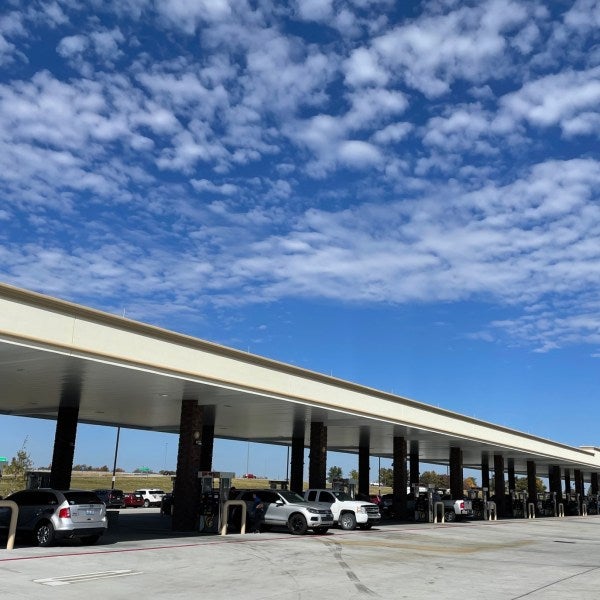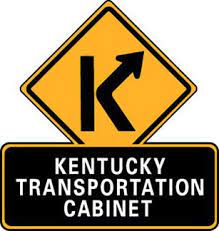Buc-ee’s is the latest roadside attraction
Published 9:00 am Friday, December 23, 2022

- Seemingly endless line of gas pumps at Buc-ee's Richmond, Kentucky, location along Interstate 75. (Photo by Keith Roysdon)
|
Getting your Trinity Audio player ready...
|
BY KEITH ROYDSON
Daily Yonder
In his book “Travels with Charley: In Search of America,” author John Steinbeck had a fairly dismal view – literally – of America’s developing interstate highway system.
“These great roads are wonderful for moving goods but not for inspection of a countryside,” Steinbeck wrote. “You are bound to the wheel and your eyes to the car ahead and to the rear-view mirror for the car behind and the side mirror for the car or truck about to pass, and at the same time you must read all the signs for fear you may miss some instructions or orders. No roadside stands selling squash juice, no antique stores, no farm products or factory outlets. When we get these thruways across the whole country, as we will and must, it will be possible to drive from New York to California without seeing a single thing.”
Now, 60 years later, the American interstate highway system, which connects cities big and small across thousands of miles of rural and sometimes desolate areas, has all but supplanted the meandering roads and two-lane highways Steinbeck favored in the book (which some considered, in retrospect, highly fictionalized).
The roadside attractions of old are relegated to places off the modern-day beaten path. One county over from where I grew up in Indiana, the town of Alexandria features what it claims is the World’s Largest Ball of Paint. I haven’t been there, but my son went once and said visitors can apply another coat of paint to help the attraction grow. The World’s Largest Ball of Paint, which has more than 23,000 layers of paint and weighs more than 4,000 pounds, has been growing for more than 30 years.
It is half a county away from Interstate 69, the major route in the area. It is the kind of roadside stop that Steinbeck might have favored, along with mom-and-pop diners and farm stands and roadhouses with the coldest beer in a hundred miles.
Every road, every state, cannot claim to have the World’s Largest Ball of Paint, or the best smashburgers or coldest beer.
Enter the new roadside attraction and oasis.
Decades after farm stands and truck stops and mega-sized truck stops like Flying J comes a popular and growing but controversial roadside oasis: Buc-ee’s, a Texas-based convenience store chain that’s spreading across southern states like kudzu with 50 locations and counting.
Buc-ee’s – which isn’t a truck stop, since it doesn’t allow trucks – is being built at Interstate 40 Exit 407 in Sevierville, Tennessee. Travelers know that exit is already one of the most used in the south, as it leads to Pigeon Forge, Gatlinburg, and the Great Smoky Mountains National Park.
It’s the latest iteration of the roadside oasis for travelers, the so-called “wide spot in the road” in the middle of nowhere, albeit a wide spot where gas pumps, at well over a hundred, outnumber the kinds of jerky.
But only barely.
The rise of the road
As highway historian Richard F. Weingroff noted on the occasion of the 100th anniversary of the Federal Highway Administration in 1993, railroads dominated cross-country travel in the last half of the 1800s. As students of history and children who played “Oregon Trail” know, traveling other than by train could be perilous and dysentery fraught. Somewhat amazingly, it was the popularity of bicycles – by 1890, more than one million bikes were being manufactured each year – to persuade America to invest in the upkeep of streets and roads. The Good Roads Movement grew out of pressure from bicycling groups to secure better roadways in rural areas.
Presidents and sessions of Congress took up the cause of roads and applied only small amounts of funding over several years, according to Weingroff’s history, and an inventory of the nation’s roads found that only about 250,000 kilometers of 3.4 million kilometers of rural public roads were paved. Meaningful federal funding followed: $75 million over five years beginning in 1916. World War I slowed highway construction because it demanded the presence of so many men and so many materials. Improvements in the National Road and other routes followed once the war was over. Numbered highways followed those and then Eisenhower’s Interstate System.
Which came first, the roads or the roadside oasis?
Weingroff – whose articles introduced me to the phrase “access control,” meaning the practice of establishing a particular number of exits along interstate highways – said that as early as the 1910s, gas stations, diners and motels were developing along the nation’s highways. Along with these practical conveniences, often located in heavily rural areas miles from the nearest population center but placed to serve travelers, were attractions like “alligator farms, ancient caverns, monkey houses, snake farms, amusement areas and hundreds of other curiosities they could explore while buying bumper stickers, knickknacks, postcards, refreshments, and memorabilia. In the September 1934 issue of Fortune, James Agee described the American roadside as ‘the most hugely extensive market . . . ever set up to tease and tempt and take money from the human race.’”
Highway builders used access control, through interstate exits, to control the flow of traffic which meant that “thousands of motorist-oriented businesses, including many ‘mom and pop’ motels, ‘greasy spoons’ and tourist attractions lost their customers and succumbed or clung to life,” Weingroff wrote.
“The Interstates have transformed our roadsides, as they did the rest of society,” he wrote. “Fixed though they are in the center of their right-of-way, the Interstates are flexible enough to adjust to the inevitable changes in our society. Americans have adapted to the new roadside, as they have to the constant evolution of our society, but the roadside has adapted as well to the way Americans live, play, and work.”
Buc-ee’s is an example of that.
Drama followed the Kentucky debut of Buc-ee’s
In Richmond, Kentucky, a new Buc-ee’s opened in April 2022 at an Interstate 75 exit, built just to suit it.
Founded in Texas in 1982 and owned by Arch “Beaver” Aplin III and Don Wasek, Buc-ee’s has grown so quickly to 50 locations – the Buc-ee’s in Crossville, Tennessee, was the 50th – that its Wikipedia page still cites 43 locations. The company grew beyond “just” stores to travel centers a little more than 20 years ago. A feature of the modern-day Buc-ee’s is not only the 70,000-plus-square-foot store but also as many as 120 gas pumps.
One thing that is notable about Buc-ee’s is that despite their gargantuan size and prime placement along highways, they don’t allow trucks. The ramp from I-75 to the store is dotted with signs proclaiming that trucks are not allowed.
On one occasion when we were there, a trucker parked his rig and started to go into the store but an employee came out and told him to leave. The trucker cursed, got back in the cab of his truck, and left.
When the Richmond location was close to opening, “People were calling us every day, wanting to know when it was opening,” Ricki Pryor, editor of the Richmond Register newspaper, said in an interview for this article.
With a population of about 100,000 people and two cities, Richmond and Berea, Madison County, is still considered rural by many definitions. It looks like a lush green county of farm fields and trees from the interstate.
Buc-ee’s coming to Madison County was not without drama even before the store opened. Nothing but family farms were located at the site and the county conveyed the land to the city of Richmond, which in turn landed the Buc-ee’s development.
“So you’re going to build this big gas station on bluegrass farmland?” Pryor said people asked. “There’s lots of worry about what this big location there will do. There’s been drama and there still is.
“Its location disturbed people in Berea, who were concerned people would blow right past us to Buc-ee’s,” she added. Berea is known for its arts and crafts community, and there were worries that Texas-made-and-imported-to-Kentucky clothing and home décor – much of it branded with the trademark Buc-ee’s beaver – would be the souvenir that would go home with travelers. There were efforts to get local wares on the shelves at Buc-ee’s.
The Draw that brings people in
Richmond is becoming known for its Buc-ees, but Madison County “is a really high-growth area, with great quality of life,” said David Stipes, executive director of the Richmond Industrial Development Corporation.
“We’re 25 miles south of Lexington, a large city, but we’re becoming a community of our own, with shopping and high-quality hospitals … Eastern Kentucky University in Richmond, Berea College in Berea, and the Bluegrass Army Depot large weapons storage facility,” Stipes said in an interview for this article. “We’re actively recruiting businesses and employers.”
Madison County has seven exits along Interstate 75 to draw from the “huge amount of traffic” on the interstate, which is the major north-south route through Kentucky.
Pryor noted a gas station not far from the Buc-ee’s site that closed before the general public was even aware that the huge travel stop was coming. Stipes said he didn’t know of any businesses that have closed in the wake of Buc-ee’s.
“On some things, Buc-ee’s could be the draw that draws people to the community, while they’re here they spend time with our other attractions.,” he said. “It’s been another attraction to bring people to Madison County. It’s a destination for travelers across the country.”
A publicist for Buc-ee’s contacted for this article did not provide answers to questions about the company and its plans.
Not for the community, but for travelers
Buc-ee’s is a novelty for travelers and perhaps for people who want to work there. Signs outside the entrance to the store feature dollar-per-hour figures for jobs in the store. Depending on the area, pay ranges from $13 to $15 an hour for cashiers, $14 to $16 for food service, and $18 and up for team leaders and managers. The positions come with three weeks of paid time off that can roll over to the next year if not used.
Pryor said the company held “two huge hiring events” and filled all its 175-or-so-person-workforce in two or three days.
“That was very exciting for our community,” she said. “Here’s this employer with a decent pay and benefits package and a night shift so there are a lot of positions.”
The company famously doesn’t allow its employees to carry their cell phones while they’re working and doesn’t allow visible tattoos. “Some were upset at that,” Pryor said. “It reminds me of Disney, the uniform, the code of conduct, you don’t see bare shelves because people are always stocking.
“It’s not built for the community that it’s in,” she added. “It’s not designed for that. They bring in travelers.”
There might be no more heavily traveled interstate exit than Interstate 40 Exit 407 at the gateway to Sevierville, Pigeon Forge, Gatlinburg, and the Smokies. Buc-ee’s didn’t answer questions for this article about when the store there – complete with a car wash more than 200 feet long – would open, but early in 2023 seems likely.
This fall, Buc-ee’s was already taking recognizable shape at the exit, where it looks over a few scattered restaurants and fireworks stores, those staples of the region.
The very size of Buc-ee’s – the Sevierville store will be the largest at around 74,000 square feet until it is topped in a few months by a new Texas store – has its detractors.
In a piece written for Paste Magazine in March 2022, Garrett Martin opined, “Buc-ee’s Is Too Damn Big.”
“It’s overwhelming, and not really in a good way, especially when the store is packed,” Martin wrote. “Buc-ee’s is a lot like Disney World. It’s huge and yet there’s still people everywhere.”
In an era that’s two or three eras past the days of the little roadside diner, gas station, or fruit stand, Buc-ee’s is in a race with itself, it seems, to go big, especially for travelers who are trying to go home.
While it’s hard to imagine just what Steinbeck would have thought, this new iteration of the roadside stop would have given him – and Charley – something to see along the highway.




